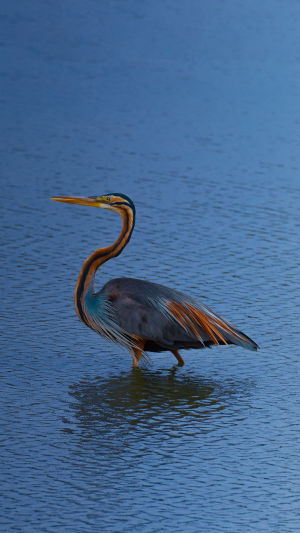There are many different species of heron, and they can be found all over the world.
They have many characteristics suitable for wading in shallow waters, namely a long bill, long neck and long legs, and the different species of heron vary greatly in shape and plumage colour.
The heron's diet consists mainly of small fish and other aquatic animals. The heron family is a large family name, with 17 genera and 62 species worldwide, some of which are protected species.
Herons are large and medium-sized wading birds, mainly found in wetlands and near woodlands, and they are important indicator species in wetland ecosystems.
They are a very ancient group of birds, having been on the planet about 55 million years ago.
The heron's habitat is to prefer rice paddies, reedbeds, lakes and streams.
The heron is a solitary bird, often alone in shallow water with reeds, with its head craned low, waiting for opportunities to catch fish and other food.
The flight is slow and heavy on the wings. Nests in large groups.
They are often found in marshes, fields, ponds and other reeds or weedy places, often in groups of three to five, feeding in shallow mudflats or paddy fields in the morning and at dusk.
Sometimes standing still in the water waiting for food, like stakes, pecking at food when it is close by, and hurrying forward to feed when it is far away.
It feeds mostly on aquatic animals and insects. Grass herons fly gently, leaping and flying in a straight line. fluttering their wings before gliding when descending, resting in trees, standing for long periods and looking out with their necks outstretched.
Great egrets are distinguished by their large size and lack of either a crest or pectoral plumage. Great egrets have an over-eyed bill and a black bill in breeding season and a yellow bill in non-breeding season.
Medium egrets are medium sized and lack a crest but have pectoral plumage, Medium egrets have an over-eyed bill and a black upper bill and bill tip in breeding season and a black yellow bill tip in non-breeding season.
The Little Egret is small, with a full crest and pectoral feathers. The beak is all black and the typical points of distinction: the feet are black but the claws are yellow.
There are several classifications of herons as follows.
Herons
Stork-like herons, with large bodies and long legs, two beautiful black crown feathers on the head. Pale grey on the upper body and white on the lower body.
They gather in small groups and nest in tall trees, using twigs, hay and feathers to build their nests. The eggs are sky blue and are found in lakes, marshes and beaches.
They can be found throughout the country.
White spoonbill
A long, flat, pipistrelle-shaped bill in the family Ibidae.
White plumage all over, throat and face bare, with orange-yellow silky crown feathers on the occiput and orange-yellow chest.
They are solitary or in small groups, nesting in tall trees near water. It lays 3-4 eggs at a time and the eggs are white.
Boat-billed Heron
A stork-like heron with a broad beak resembling a small boat.
It has a greenish-black crown at the back of its head and is similar in shape to a night heron. It lives along densely vegetated rivers and is active at night, and is found in tropical America.
There is only one genus and one species in the world.
Rock Heron
It is a highly territorial species. Occupying a small patch of reef or shore and usually only found on rocky shores, often perched on the rocks or leaping over the waves, flying close to the surface.
There are a number of rock herons roosting on the islands all year round!





